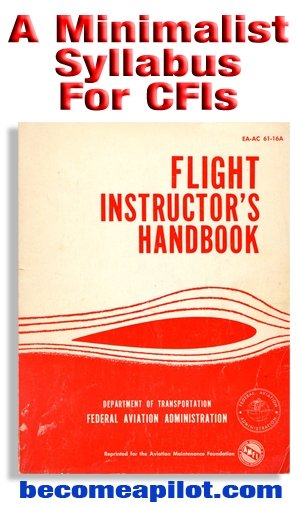 This link takes you to a page where you can download a PDF of the FAA’s original private pilot syllabus published in 1971. This syllabus was found in the back of the old FAA Flight Instructor Handbook which is no longer available. The newer flight instructor handbook no longer contains a syllabus.
This link takes you to a page where you can download a PDF of the FAA’s original private pilot syllabus published in 1971. This syllabus was found in the back of the old FAA Flight Instructor Handbook which is no longer available. The newer flight instructor handbook no longer contains a syllabus.
This is a minimalist syllabus and is one of the very best syllabi I’ve found for preparing someone for the private pilot certificate–or the sport pilot certificate (no need to do electronic navigation or some instrument training). It’s the method by which thousands upon thousands of pilots successfully earned their pilot certificate over the years with minimum cost.
What makes this syllabus unique is that it’s a “Stick and Rudder” syllabus and makes no attempt to teach a student things he or she doesn’t need to immediately know during flight training. I heartily recommend using this syllabus for anyone training under Part 61 of the regulations. For students training under Part 141 of the regulations, they should use the syllabus the FAA has approved for that particular flight school.
And, of course, if you feel that other aspects of aviation should be added to this syllabus, then have at it. But please remember that your objective when teaching someone how to fly is to “teach them to fly.” Your objective is not to make them into the general aviation version of an “airline pilot lite.” Since private pilot training is already scenario-based by design, you’ll see that there are no make-believe flight scenarios in these lessons with which to distract the student. These lessons also assume that you’ll take your student to the practice area and actually “practice” the flight maneuvers listed. You are not expected to take your student on a cross country flight (however short) while you simultaneously try teaching them how to fly. (Read my AOPA Pilot Article titled, In Defense of Stick and Rudder Training due out in March 2012 for more info on the value of stick and rudder training.)

For the student reading this, keep in mind that this syllabus provides for ground instruction prior to each lesson. It’s important to understand that your ability to do well in the air is based on having a lot of good ground instruction. In fact, an acceptable format is to have at least one hour of ground instruction for every hour of flight instruction given. And you would be expected to pay for your instructor’s time at his or her full hourly rate, too (in the long run you’ll end up paying a lot less for your training as a result of good ground instruction).
What does ground instruction offer you? It makes the lessons far more meaningful. Good ground instruction and a lot of it is what allows students to solo in 10-14 hours and obtain their private pilot certificates in the range of 45 hours (training two to three times a week, of course). That’s a fact. Now, I realize that a one-to-one hourly ratio of ground to flight instruction is a lot for some folks (in particular, their instructors who want to fly), but this certainly isn’t an unreasonable request. Those flight schools offering accelerated flight training who are able to move students through the private pilot curriculum in three weeks or less (with approximately 42 hours of flight time) do so because they provide a lot of ground training prior to each lesson.
So try convincing your flight instructor to spend more time with you on the ground explaining the details of the lesson, reviewing what’s expected of you, running through the procedures, steps and techniques to be practiced.
Additionally, many of the higher order cognitive skills that are all the rage to teach nowadays (situational awareness, aviation decision making, risk assessment and so on) can be learned just as well on the ground or in a simulator as they can in the air (no, not all of them, but certainly most of them). In fact, these skills are often better acquired on the ground by reading good books, studying DVDs and/or attending aviation seminars in person or via the web.
Finally, for any student reading this, send your instructor this link. Let him or her know that you are interested in using a “minimalist” syllabus (this one or another one your instructor prefers) for flight training. Of course, your instructor knows best and will decide whether or not this fits his or her training philosophy.
Sincerely,
Rod Machado
